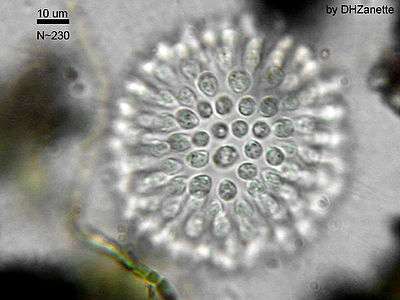Choanozoa
| Choanozoa | |
|---|---|
 | |
| Sphaeroeca, a colony of choanoflagellates (approx. 230 individuals) | |
| Scientific classification | |
| Domain: | Eukaryota |
| (unranked): | Opisthokonta |
| Phylum: | Choanozoa Cavalier-Smith, 1987[1] |
| Classes and unplaced genera | |
Choanozoa (Greek: χόανος (choanos) = "funnel" + ζῶον (zōon) = "animal") is the name of a phylum of eukaryotes that belongs to the line of opisthokonts.
Most appear closer to the animals than to the fungi, and they are of great interest to biologists studying animal origins.
The nucleariids seem to be a sister group to the fungi, and as such tend to be excluded from the Choanozoa.[2]
Choanozoa have been described as possessing a posterior cilium.[3]
Cladogram
| Opisthokonta |
| ||||||||||||||||||||||||
| |
The great kingdoms and their close relatives.[4]
Classification
The Choanozoa consist of at least 7 groups: (1) the Mesomycetozoea (Ichthyosporea), a group of parasites infecting fish and other animals, (2) a group described in the early 21st century including Ministeria and Capsaspora, which has been named Filasterea after the thread-like tentacles which both genera share, and (3) the choanoflagellates including Monosiga and Proterospongia.[2][5] The position of Corallochytrium is unclear.[2]
The Choanozoa appear to be a paraphyletic group which gave rise to the animals. Lang et al. (2002) propose the new name Holozoa for a monophyletic grouping which is, in effect, Choanozoa enlarged or redefined to include animals.[6]
See also
References
- ↑ Cavalier-Smith, T. (1987). The origin of fungi and pseudofungi. In A.D.M. Rayner, C.M. Brasier & D. Moore (Eds), Evolutionary Biology of the Fungi, pp. 339-353.
- 1 2 3 Shalchian-Tabrizi K, Minge MA, Espelund M; et al. (2008). Aramayo, Rodolfo, ed. "Multigene phylogeny of choanozoa and the origin of animals". PLoS ONE. 3 (5): e2098. doi:10.1371/journal.pone.0002098. PMC 2346548
 . PMID 18461162.
. PMID 18461162. - ↑ Cavalier‐Smith, T. (2009). "Megaphylogeny, cell body plans, adaptive zones: causes and timing of eukaryote basal radiations". The Journal of eukaryotic microbiology. 56 (1): 26–33. doi:10.1111/j.1550-7408.2008.00373.x. PMID 19340985.
- ↑ Phylogeny based on:
- Eichinger, L.; Pachebat, J.A.; Glöckner, G.; Rajandream, M.A.; Sucgang, R.; Berriman, M.; Song, J.; Olsen, R.; Szafranski, K.; Xu, Q.; Others, (2005). "The genome of the social amoeba Dictyostelium discoideum". Nature 435 (7038): 43-57. doi:10.1038/nature03481.
- Steenkamp, E.T.; Wright, J.; Baldauf, S.L. (2006). "The Protistan Origins of Animals and Fungi". Molecular Biology and Evolution 23 (1): 93-106. doi:10.1093/molbev/msj011.
- Cavalier-Smith, T. (2003).Protist phylogeny and the high-level classification of Protozoa, Europ. J. Protistol. 39, 338-348.
- ↑ "Eukaryotes".
- ↑ Lang B.F.; O'Kelly C.; Nerad T.; Gray M.W.; Burger G. (October 2002). "The closest unicellular relatives of animals". Current Biology. 12 (20): 1773–78. doi:10.1016/S0960-9822(02)01187-9. PMID 12401173.
| Wikimedia Commons has media related to Choanozoa. |